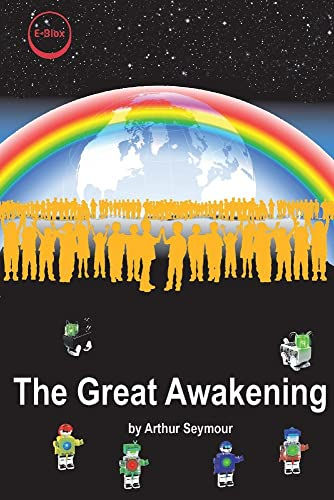A Review of Arthur Seymour’s The Great Awakening
- wanjohimuch
- Aug 11, 2023
- 3 min read

In [i]The Great Awakening, [/i] Arthur Seymour describes how a small village located inside a cave was hit by a pandemic that it had to be locked down for some time before the cure was found. This happened ten years after Seymour and Ruby got married and had four children; Jimmy, Andy, Joey, and Stacey. The first scene described in the book is when the couple is sitting on the balcony of their palace and an albino crow named Sally brings them elderberry from the field. They take it to the lab for Doctor Paul to examine it with the assistance of Ester who is at the REED headquarters. The humanoid robots named Robyn, Min, and Feeniks help the family, Paul, and Ester respectively. Andy and Joey have made a fortune-telling machine that would answer any questions that anyone had, but it always answered, “Soon.” The second chapter of the book reveals that there is a contagious disease that is putting people in a coma all around the world. As a result, the whole village was put in total lockdown, thereby leaving no access to the outside world. As they search for the solution to the situation, Seymour realizes that using Glen’s gift of controlling software in computers would end the comavirus. Glen was the main character in the previous book written by Seymour called [i] Earth Won, [/i] but he appears in the form of a moth called Moses. By using the gift, they developed a three-step plan to stop the comavirus that involved putting the infected people into hospitals, taking them out of the coma, and stopping the Creature that brought the pandemic. Eventually, the team discovers a code that ends the comavirus and all the infected people wake up. To combat the enemy robots working for REED, a young boy named Martin suggests that they adopt a peaceful and loving solution without punishing the soldiers. Toward the end of the book, Paul and Ruby ask many questions and Robyn tries to answer them by explaining the nature of the metaphysical world. Throughout the book, the author has included poems that encourage goodness and love for humanity because those are the values that guided the team in ending the pandemic.
One of the positive aspects of the book regards the organization of the scenes or setting and characterization. I liked the way the scenes are described and intertwined based on the activities engaged by the characters, for example, Chapter 1 begins with a scene at the palace, then at the lab, and finally at the playroom. It is also interesting how the author has characterized animals such as moths, dogs, birds, and cats to speak like human beings because that reveals the level of humorous fiction used in the book. Another positive aspect is that Seymour has included pictures of the characters, scenes, and objects to support the content such that readers can visualize what the story is all about. The narrative also includes poems, songs, and limericks that help the character make difficult decisions during the comavirus pandemic. It is also interesting how the fictional comavirus pandemic in the book resembles the COVID-19 pandemic, and yet the author had no idea it would come when he wrote the book. Lastly, the book was professionally edited since there were no spelling or grammar mistakes.
After searching for the negative aspects, I found almost none because the book is thoroughly proofread and the author provides an option for readers to edit the book by using certain Internet links. Also, there is no use of vulgar or informal language in the book. Perhaps, the only shortcoming of the book would be the use of images obtained from Pixabay.com and yet the author did not include any citations.
By considering the editing of the book and the number of strengths versus weaknesses, I would give this book a rating of [b] 4 out of 5 stars. [/b] The positive aspects are many by far as compared to the negative aspects. Also, the lack of grammar mistakes in the book justifies a positive rating. The only issue was the lack of notes and references for the images used throughout the book.
I would recommend the book to children, especially those who like science fiction. This is because the language used in the book is pretty simple and, therefore, easy to understand. Those young learners in grades 1 to 6 can find the book interesting and relevant to their literature studies. Also, adult enthusiasts of science-fiction stories can find the book to be comical and interesting as well.




Comments